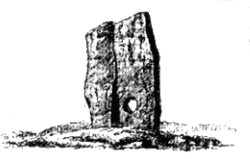We've been taking the lambs out most days for a walk... it's a bit like having dogs! This week we went to the Stan Stane, a dialect term simply meaning "standing stone"standing stone. The Standing Stone goes back 5000 years to Neolithic times. Over 13 feet high and three feet wide, the stone tapers from its base, narrowing slightly towards the top. The stone is the focal point for a centuries-old North Ronaldsay New Year custom that has seen the island's inhabitants gathering around it and singing.

The Stone has a small hole through it. This stone is similar to the Stone of Odin, which until 1814 stood on Orkney mainalnd, at the Brig of Brodgar in Stenness. The hole through the Stone of Odin was big enough for a couple to reach through and hold hands, which they did “upon the first day of every new year”, according to the minister of Greyfriars Church in Edinburgh, Mr R. Henry, who visited Orkney in the late 1700s. This, he said, led to marriages. Rev George Low, who wrote in 1774 describing a custom with couples who joined their hands through the stone and "there swore to be constant and faithful to each other. This ceremony was held so very sacred in those times that the person who dared to break the engagements made here was counted infamous, and excluded all society". In the image below, taken from Rev George Low's book shows the Kirk of Stainhouse (A), the Standing Stones (known as the Temple of the Moon, C), and a stone which had a round hole cut artificially through it, six inches in diameter, 3 feet above the ground (Odin Stone, D). Can you see the couple holding hands through the stone?


This poem appears in The Orcadian newspaper in 1860:
A basket clad with moss that grew
Upon the Stones of Stennis,
The 'Standing Stones' that long ago
(How long beyond my ken is)
Served as the temple of a god,
Whose name I cannot tell;
Some say 'twas warlike Odin, some
'Twas ancient Baal or Pel,
And some that mid the sacred ring
Was placed an altar stone
Where Druids grim, with awful rites,
Ador'd "The God Unknown"
My grannie minds one upright stone,
Where lovers took their stand;
'Twas b’rd quite through, and in the bore,
Hand met with loving hand.
A solemn grasp it was, for oft
I’ve heard my grannie say,
The hand that falsified the pledge
Was sure to rot away!
That stone is broken down, and now
These pledging times are o'ver.
Could they not bore another stone,
And use it as before?
Handfasting was one of several older forms of marriage that had survived into the Christian era by being developed into a system of trial marriage. With divorce not allowed and with the need to discover if a bride could become pregnant, systems of trial marriage emerged, a man and a woman living together for a year, but being free at the end of the year, unless they chose to stay together. Another example was marriage at the church door with the full marriage itself then taking place inside the building at a later date. However, the handfasting which took place at the Odin stone was "considered more peculiarly binding than any other" and known as the promise of Odin.
Nearby at the Kirk of Stainhouse (Stenness) couples who could not agree and wanted a divorce could come to the Kirk, "one went out at the south and the other at the north door, by which they were holden legally divorced, and free to make another choice."
The Stone of Odin stood on some land belonging to ferrylouper (non-Orcadian) Captain W. Mackay. The Stenness megaliths continued to play an important part in the lives of Orcadians. He became fed up with people crossing his land regularly to visit the stones and ploughing around them and decided to get rid of them. In December 1814 the Stone of Odin was destroyed. Infurated by this, many Orcadians stormed Machay's farm and attenpted to burn down his home. On Christmas Day that year a court order was taken out to prevent any further damage to the stones, and Mackay fled back to mainland Scotland in fear of his life.

The Stan Stane on North Ronaldsay has been standing as long as the native sheep have been on the island. I wonder what ancient traditions concerning the stone there were over the millennia that have long since been forgotten...
Yesterday my first volunteer (and lodger) Elizabeth arrived. Elizabeth if a vet student from Cambridge and is here 3 weeks to learn about the North Ronaldsay sheep and help build the dyke!

.jpg)